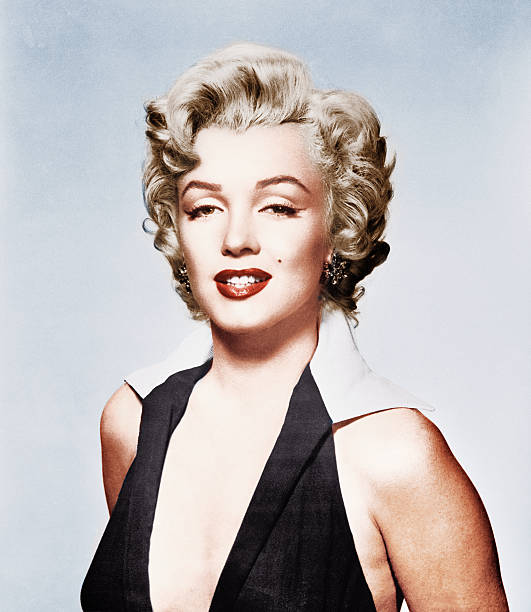Table of Contents
Marilyn Monroe (born Norma Jeane Mortenson; June 1, 1926 – August 4, 1962) was an American actress and model who became one of the most famous and enduring icons of Hollywood. She grew up in a troubled childhood but eventually rose to stardom in the 1950s, starring in hit films and cultivating a glamorous “blonde bombshell” image. By the early 1960s she was one of Hollywood’s top box-office draws (her films had grossed about $200 million by the time of her death). Despite her fame, Monroe’s personal life was often difficult, and she died at age 36 from a barbiturate overdose, a death officially ruled a “probable suicide”. Decades later, she remains a pop culture icon – in 1999 the American Film Institute ranked her the sixth greatest female screen legend of all time – and her image and story continue to fascinate new generations.
Early Life and Childhood
Norma Jeane Mortenson was born on June 1, 1926, in Los Angeles, California. Her mother, Gladys Baker, struggled with mental illness and was often hospitalized, so Norma Jeane spent her early years shuttling among foster homes and even an orphanage. As a child she endured hardship – biographers report that she was abused and felt abandoned during her years in foster care. She later recalled finding escape by going to the movies as often as she could. By age 15 Norma Jeane had left high school and, to avoid returning to the orphanage, married her 20-year-old boyfriend, factory worker James “Jim” Dougherty, on June 19, 1942, just after her 16th birthday.
In those war-time years Dougherty was serving overseas, and Norma Jeane worked in factories. In April 1944 she took a job at the Radioplane munitions plant in Van Nuys, California. There she was noticed by U.S. Army photographer David Conover, who was taking pictures of factory workers to boost morale. Conover’s photos of her, along with her good looks and hard work, led Norma Jeane into modeling (she also signed with Blue Book Modeling Agency in 1945). She changed her naturally brown hair to a bright platinum blonde, a look that soon became her trademark.
Rise to Stardom
In 1946 Norma Jeane signed a short-term film contract with 20th Century Fox – the studio chose a new name for her, Marilyn Monroe (the first name evoking Broadway star Marilyn Miller, the surname her mother’s maiden name). She and Dougherty divorced that year, ending a marriage he later said he began as a favor to keep her out of the orphanage. Monroe spent the late 1940s learning to act and appearing in bit parts. After a brief stint at Fox (including small roles in Dangerous Years and Scudda Hoo! Scudda Hay!), she was let go by Fox and signed a contract with Columbia Pictures in 1948. There she had her first starring role in the low-budget musical Ladies of the Chorus, but the film was not a hit.
Still working as a model, Monroe posed for the famous nude calendar photos by Tom Kelley, using the name “Mona Monroe” for those pictures. In 1950 she met talent agent Johnny Hyde, who became her mentor. He helped her land two small but important roles that year: in The Asphalt Jungle and All About Eve. Even though these roles were brief, they drew notice – the great actress Bette Davis later said Monroe showed real talent and drive in All About Eve.
Monroe’s big breakthrough came in the early 1950s. By 1953 she was playing leading roles in major studio films: she starred in the film noir Niagara (1953), and co-starred in the hit comedies Gentlemen Prefer Blondes (1953) and How to Marry a Millionaire (1953). These films cemented her image as Hollywood’s new “blonde bombshell” (sometimes dubbed a “dumb blonde” for comic effect) and made her a box-office star. That same year her early nude photos caused another sensation – one of her calendar images became the centerfold and cover of the very first issue of Playboy magazine (1953). Surprisingly, this scandal only increased public interest in Monroe and raised her fame even higher.
Monroe also pushed for greater creative control over her career. She formed her own company (Marilyn Monroe Productions) in 1954 and studied method acting under Lee Strasberg in New York in 1955. In 1954 she won a new, higher-paying contract with Fox. Over the next few years she proved she could act as well as enchant audiences. In 1955 she starred in Billy Wilder’s comedy The Seven Year Itch, which became one of the biggest hits of her career. Critics also praised her dramatic turn in Bus Stop (1956). In 1957 Monroe produced and co-starred with Laurence Olivier in The Prince and the Showgirl, earning a BAFTA nomination. One of her most famous roles came in 1959, when she starred in the romantic comedy Some Like It Hot – she won a Golden Globe Award that year for Best Actress (Musical or Comedy). Her final completed film was The Misfits (1961), written for her by then-husband Arthur Miller, though it was not a commercial success.
Personal Life and Relationships
Marilyn Monroe’s personal life attracted as much attention as her films. She was married three times. Her first husband was Jimmy Dougherty (1942–1946), the childhood friend she married at 16 to avoid foster care. In 1954 she wed New York Yankees baseball legend Joe DiMaggio – the elegant wedding took place quietly at San Francisco City Hall on January 14, 1954. DiMaggio adored Monroe, but he grew unhappy with her public image. They divorced just nine months later, with Monroe citing “mental cruelty” as the reason. DiMaggio famously remained devoted to her memory, sending roses to her grave for 20 years after her death.
Monroe’s third marriage was to playwright Arthur Miller. They married on June 29, 1956, but the relationship was troubled. Monroe suffered two miscarriages and an ectopic pregnancy during this period. The marriage ended in divorce in January 1961. Monroe also had high-profile romances with other famous men, including actors Marlon Brando and Frank Sinatra, French actor Yves Montand, and director Elia Kazan.
One of the most persistent public rumors concerned President John F. Kennedy. Monroe attended Kennedy’s 45th birthday gala at Madison Square Garden on May 19, 1962, where she gave a now-famous sultry performance of “Happy Birthday, Mr. President”. This performance – along with accounts from people who knew her – fueled speculation that Monroe and Kennedy had a romantic affair. (No definitive proof ever surfaced, and other sources note Monroe was also linked to Robert Kennedy around this time.) In public, Monroe was often described as a gentle, vulnerable woman behind her glamorous persona. She was known to be shy off-camera and worked hard to be taken seriously as an actress.
Challenges and Struggles
Beneath Monroe’s public glamour, she faced many personal struggles. She battled chronic anxiety, depression and low self-esteem for years, and became increasingly dependent on prescription drugs. By the early 1960s she was using amphetamines and barbiturates to cope with fatigue and insomnia. Colleagues sometimes found her difficult to work with – she had a reputation for lateness on set and for resisting the studio’s control. These problems led to lost opportunities: for example, film producers in 1960 chose not to cast her as Holly Golightly in Breakfast at Tiffany’s, fearing production delays.
In 1961 Monroe underwent major medical treatments: she had surgery for endometriosis and gallbladder removal, and she spent time in a hospital and even a psychiatric ward for severe depression. That year she also negotiated the formation of her New York Actors Studio training. Despite her efforts, her later films – Let’s Make Love (1960) and The Misfits (1961) – failed at the box office. In early 1962 she was cast in a remake, Something’s Got to Give, but recurring illnesses kept her away from the set. She was briefly fired by 20th Century Fox in June 1962 for missing too much work (the studio later agreed to rehire her, but the film remained unfinished). In interviews at this time she acknowledged being exhausted and overwhelmed. By mid-1962 Monroe had largely withdrawn from public life.
Death and Aftermath
In the early hours of August 5, 1962, Marilyn Monroe was found dead in her home in Brentwood, Los Angeles. Investigators determined that she had died the night before, on August 4, of an overdose of sleeping pills (barbiturates). She was 36 years old. The official coroner’s report labeled her death a “probable suicide,” citing her history of drug abuse and depression. However, Monroe’s sudden passing at the height of her fame gave rise to endless speculation. Conspiracy theories circulated that powerful men – including President Kennedy or his brother Robert – might have been involved. In 1982 the Los Angeles District Attorney reviewed the case and concluded there was no new evidence to overturn the original finding.
Monroe’s funeral in late August 1962 was a small, private affair. Her ex-husband Joe DiMaggio arranged the service and famously kept flowers on her grave for decades. Director John Huston (who had worked with her) gave the eulogy. In the end, Monroe left behind few possessions; one treasured memento was a signed photo from Albert Einstein inscribed “With respect and love.” Her Hollywood friends remembered her as talented, sweet, and vulnerable – in Truman Capote’s words, “warm and beautiful and gentle.”
Cultural Legacy
Marilyn Monroe’s image and story have endured far beyond her lifetime. She remains one of the quintessential figures of 20th-century pop culture, a symbol of Hollywood glamour and the complexities of fame. Her “dumb blonde” persona – epitomized by iconic scenes like her billowing white dress in The Seven Year Itch – is immediately recognizable around the world. Monroe’s influence on fashion and beauty standards is still felt; designers and performers continue to cite her as an inspiration. In 1999, reflecting her lasting impact, the American Film Institute ranked Monroe as the sixth-greatest female screen legend of all time.
Countless books, documentaries and films have explored Monroe’s life, and artists from Andy Warhol to Madonna and Lady Gaga have paid tribute to her image. As the Hollywood Walk of Fame notes, she “has often been cited as a pop and cultural icon” in the years since her death. In sum, Monroe’s legacy is that of a talented actress who created an unforgettable persona – and whose personal struggles and untimely death helped cement her status as a tragic, enduring legend of the silver screen.
Read Also – Salish Matter: A Rising Star in Social Media and Gymnastics

